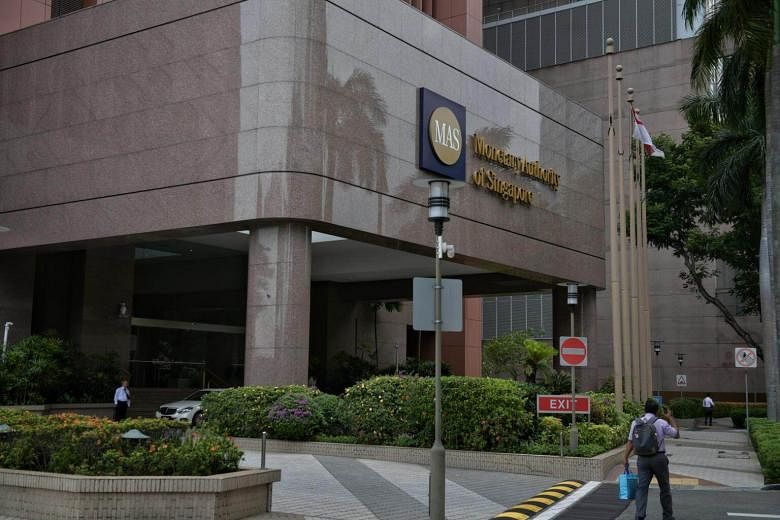SINGAPORE - Singapore's central bank tightened monetary policy for the second time this year, announcing it will allow the local currency to strengthen a little faster, as it sees an economy growing at a slower but steady pace amid rising trade tensions.
The Monetary Authority of Singapore (MAS) said in its bi-annual policy review on Friday (Oct 12) that it would slightly increase the slope of the Singapore dollar's nominal effective exchange rate (S$NEER) policy band. The width and level of the policy band, its other two levers, remain unchanged.
Following the announcement, the Singapore dollar gained less than 0.1 per cent to 1.3758 against the US dollar.
The MAS move was in line with the expectations of 11 out of 20 analysts in a Reuters poll.
Economists saw price pressures as a reason in favour of further tightening, despite potential fallout from escalating trade tensions between the United States and China.
The MAS ended two years of neutral policy at the last review in April, moving to a path of a modest and gradual appreciation of the currency and marking the first monetary tightening in six years.
Of the further increase, the MAS said in a statement on Friday (Oct 12): "(This) is consistent with a modest and gradual appreciation path of the S$NEER policy band that will ensure medium-term price stability."
"The Singapore economy is likely to remain on its steady expansion path in the quarters ahead, keeping output slightly above potential," it added, noting that core inflation will experience modest but continuing pressures before levelling off at just below 2 per cent over the medium term.
The further tightening comes as Singapore's economy grew by 2.6 per cent compared to a year ago in the third quarter, following strong average growth of 4.3 per cent in the first half of the year, according to Ministry of Trade and Industry (MTI) advance estimates released on the same day.
On a quarter-on-quarter basis and seasonally adjusted, the economy expanded by 4.7 per cent in the July-September period, faster than the 1.2 per cent growth in the previous quarter.
DBS senior economist Irvin Seah said the MAS' latest move aligns with that of the global monetary environment, with key central banks around the world tightening their monetary policies as well.
"Today's gross domestic product figure has reaffirmed the fact that the Singapore economy has remained very resilient; we see expansion across almost all key sectors," he added. "That is a clear sign that despite earlier concerns and worries about the impact of the trade war and tighter monetary conditions, our companies are holding up fairly well."
Meanwhile, Singapore's key inflation gauges returned into the upper half of their official forecast ranges in August.
Headline inflation stood at 0.7 per cent, while core inflation was 1.9 per cent for the second straight month - keeping up the fastest rate of increase since August 2014.
The MAS said on Friday that in the quarters ahead, imported inflation is likely to increase due to higher global oil and food prices, and improving labour market conditions are likely to underpin a faster pace of wage growth as well.
"The pass-through of higher import and labour costs to consumer prices could increase as domestic demand strengthens further," the MAS said.
It added that private road transport costs are expected to rise next year too, due to anticipated tapering in the supply of Certificates of Entitlement for vehicles.
While there is a risk that core inflation could still see some upward pressure, Maybank Kim Eng economist Chua Hak Bin said: "The storm clouds are here and we are not as optimistic in terms of the growth outlook, especially for next year."
Citing the United States-China trade war, which will likely pick up a notch with upcoming tariff hikes, he added: "The risk is that an abnormally strong Singdollar might hurt manufacturing, exports, and could also hurt some of the services industries as well, such as tourism and potentially, investment."
ING chief economist Robert Carnell sounded a cautious note as well. Given the uncertain external environment, he said, the MAS could have afforded to wait and see how much momentum is going to slow before tightening measures.
The MAS uses the exchange rate as its main monetary policy tool to strike a balance between inflation from overseas and economic growth.
The rate is managed against a basket of currencies of Singapore's major trading partners, and is allowed to float within a policy band that can be adjusted when monetary policy is reviewed.
A stronger currency - which corresponds to tighter monetary policy - counters inflation by making imports cheaper in Singdollar terms, while a weaker Singdollar helps to lift growth by making exports cheaper abroad.


